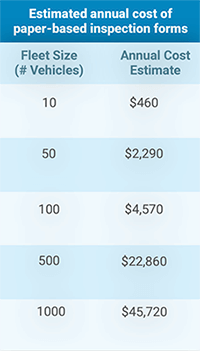Vehicle Inspection Checklist: A Guide to Smarter, More Efficient Inspections
The cost of paper vehicle pre-trip inspection forms
Drivers can only complete daily vehicle inspection forms as quickly as they can assess vehicles and write. If a maintenance issue pops up, more time is added as the driver writes or draws a description of the failure. The same issues apply to post-trip inspections as well.
There might also be a lag time in addressing vehicle issues based on when the inspection report actually gets turned in. If fleet administrators are manually entering inspection data into Excel or filing physical reports, this adds time to the process.
Since the average inspection logbook costs $3.81 and lasts about a month, the annual cost—particularly for larger fleets—is significant. Plus, paper-based inspections can also introduce other unwanted risks like missing critical maintenance issues that often lead to reactive costs and increased vehicle downtime.
Paper-based vehicle inspection checklists are static
On paper-based vehicle inspection forms, it’s impossible to add specific instructions for drivers, which eliminates the risk of misinterpretation. Drivers must physically transfer paper-based inspection forms to the fleet manager.
During this period, the fleet manager is unaware of the current status of the fleet vehicle. There is also a risk of the inspection checklist form becoming damaged or lost during the transfer between parties. Once the fleet manager has inspection forms in hand, there may be confusion about maintenance issues due to illegibility or lack of detail.
Benefits of electronic pre-trip inspection checklist
- Saves time it takes to conduct vehicle inspections
- Enables better communication among operators, mechanics and administrators
- Allows fleets to take immediate action on vehicle issues
- Transforms fleet vehicle management, while eliminating paper-based inspection inefficiencies
A new approach to fleet vehicle inspection checklists
Fleetio offers a modern, electronic alternative to paper-based vehicle inspection forms that prioritizes efficiency, accuracy and issue resolution.
“The simplicity of mobile inspections has been a game-changer for our drivers— clean, easy-to-use inspection forms that don’t get lost in the shuffle.” – George Buckner, Chief Information Officer at CFEC
The implementation of electronic vehicle inspection forms will relieve drivers from the burden of paper inspection checklists and improve inspection quality—all from an existing smartphone or tablet. Unlike paper, electronic inspection reports are accessible anytime, anywhere with Fleetio.
- Mobile access: Scan a barcode and seamlessly conduct inspections from a mobile device.
- Driver instructions: Onboard new employees and ensure consistent reporting by providing prescriptive inspection criteria for each driver.
- Upload photos and comments: Attach media to any inspection item to provide clarity between operators and maintenance teams.
- Set reminders: Alert drivers when vehicle inspections are due, ensuring inspections are completed as scheduled.
- Compliance: Access inspections history directly from the Fleetio Go mobile app, making it easy to produce records for law enforcement on the road.
- Data consistency: Ensure odometer readings are always accurate to ensure that you never question vehicle data.
- Monitor inspection integrity: Automatically track the GPS location of every inspection item on a form, alerting you to potential untrustworthy submissions.
Create tailored vehicle inspection forms
Every fleet has its own unique challenges to conduct inspections efficiently. With Fleetio Inspections, vehicle inspection forms can be customized to meet your fleet’s specific inspections criteria and can easily be adjusted as needs change.
- Custom inspection form builder: Get started right away with preloaded DOT, MOT and Fleetio suggested trip inspection forms, or build your own from scratch with the easy-to-use drag-and-drop editor.
- Flexible field values: Choose from pass/fail, meter entry or open answer text fields to create criteria specific to your fleet.
- Specialized forms: Customize inspection criteria, descriptions and provide instructions for drivers, ensuring high-quality responses.
Scheduling vehicle inspections
Fleet ops teams should be working smarter, not harder. Custom workflows help maximize operational efficiency and swiftly resolve issues.
- Scheduling: Select specific vehicles for inspection, schedule frequency and alert drivers when inspections are due, ensuring an always-compliant fleet.
- Custom workflows & notifications: Automatically trigger a change in vehicle status, open an issue and alert the appropriate people via email when inspection items fail, reducing asset downtime.
- Precise triggers: Create schedules and workflows based on specific vehicle details such as type or location. Rules apply to all current and future vehicles meeting the criteria.
About the Author
Join to The Fleet Management Group
 In this group, you can know and share knowledge, experiences and meet people interested in Fleet Management over the world. Each week we publish posts, conferences, news, scientific papers, and technology related to Fleet Management.
In this group, you can know and share knowledge, experiences and meet people interested in Fleet Management over the world. Each week we publish posts, conferences, news, scientific papers, and technology related to Fleet Management.
The Fleet Management group
 I´m a Fleet Management expert, and the manager of Advanced Fleet Management Consulting, that provides Fleet Management Consultancy Services.
I´m a Fleet Management expert, and the manager of Advanced Fleet Management Consulting, that provides Fleet Management Consultancy Services.






